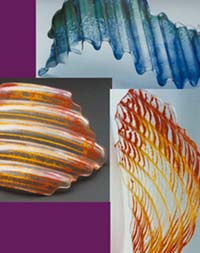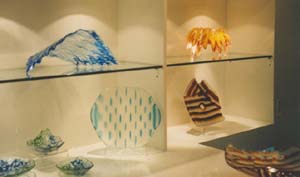
The sparkling glass apple in the Japanese drama "Love Generation" has aroused a great deal of interest in glass ornaments.
Glass sculptures have long been popular in foreign countries like Britain, but they have just gained popularity in Hong Kong in recent years.
Ms Angeline Kwok, 49, teacher, is one of those who are interested in glass sculptures. She started learning to make glass sculptures about four years ago.
Years before learning glass sculptures, Ms Kwok has had interest in drawing and making pottery.
"I saw a lot of glass sculptures in many foreign countries where I travelled.
"Exhibitions of glass sculptures, presentations of glass-blowing and other methods of glass making were held in those places," Ms Kwok said.
She became interested in glass sculptures which are similar to pottery in her eyes.
"Although glass sculpture is different from pottery, they are closely related.
"I want to achieve a breakthrough in pottery by learning to make glass sculptures," she added.
With the skills in glass sculpture making, she is planning to make an ornament which is the combination of glass and pottery.
 In the initial learning period, she made small simple glass utensils
for practical use.
In the initial learning period, she made small simple glass utensils
for practical use.
Later, she turned to making glass sculptures for house decoration.
She said: "I am fond of glass sculptures since they are translucent and they give feelings of cool."
Sculptors never get bored because they can make changes in the pattern, the shape and the size of their works.
Glass sculptures can be flat or three-dimensional. Different combinations of color give fresh and attractive appearances to them.
Ms Kwok has learnt to make various kinds of glass products ranging from small plates to bigger ornaments for decoration.
As she knows she is not good enough in this field, she tries her best to improve her skills and designs.
"Reading more relevant art books, attending gallery exhibitions and presentations, and observing others' sculptures help improvement," she said.
Some people make glass sculptures for leisure while others turn to be professional sculptors who run businesses and open courses.
Mr. Clifford Miller, 65, is a master sculptor. He is often seen holding two long thin pieces of glass in his hands and turning them into sculptures. His demonstration of making glass sculptures often attracts spectators.
 Mr. Miller gained the skills of capturing the anatomy and gracefulness
of figures and animals in Art College in Britain.
Mr. Miller gained the skills of capturing the anatomy and gracefulness
of figures and animals in Art College in Britain.
Then he worked as a glass blower in a factory and there he acquired the knowledge of glass manipulation.
After years of employment, he started his own business to make glass figures in 1954.
He combined work with interest. "I still enjoy making glass sculptures even after working in this field for nearly 50 years," he said.
Working in his interested field encourages him to seek improvement. Mr. Miller said: "I have improved my skills over the years."
His works are widely recognized. He has demonstrated his art in many parts of the world and has been invited to appear on BBC and ITV programs.
 Another professional sculptor is Alice Ng. She is one of the countable
few glass sculptors who offer courses in Hong Kong.
Another professional sculptor is Alice Ng. She is one of the countable
few glass sculptors who offer courses in Hong Kong.
She learnt to make pottery in the terrority. Then she went to Britain to get a degree in traditional glass sculpture making.
She set up an art studio with friends to offer courses on ceramics, glass and jewellery. That started her life of teaching about glass sculptures.
"I have given up a lot for art. As a degree holder, I should have earned a stable and good salary if I worked in a government department," said she.
However, she has chosen to be an artist.
She has no regrets as she values art more than money. She thought she has gained lots of non-monetary returns from her teaching. She said: "I have made friends with my students who come from different walks of life.
"Moreover, I have become more patient after years of making glass sculptures which require quite some time to finish."
The formation of most glass sculptures that Ms Ngteaches involves a process of heating and cooling within a kiln.
As glass is fragile, it should be handled with care so as to avoid cracks. The process is time consuming. Larger works demand more time.
In fact, making the work usually requires about two hours only and the instructor carries out the heating and cooling process.
The works of Mr. Miller are different. He does lamp-work for sculptures. Other works like drinking glasses and vases are made by glass blowing. They do not need to be put into a kiln.
According to Mr. Miller, being able to manipulate hot molten glass and having an artistic background are the basic requirements for glass sculpture making.
"It is difficult to get the right shape of the glass as we cannot pick up the hot molten glass with our fingers," he said.
However, Ms Kwok said an artistic background is a bonus but not a must. "My friends did not know how to make art works, but eventually they did better jobs than I."
Ms Kwok is not afraid of the hot molten glass. "I have never gotten hurt nor seen any accidents happen. It is not dangerous as long as we follow the instructions of the teacher," said she.